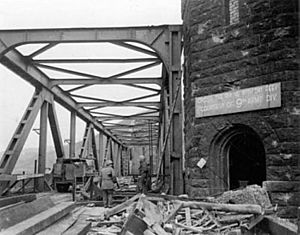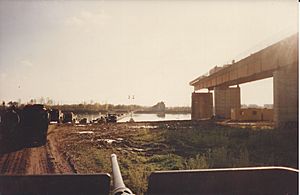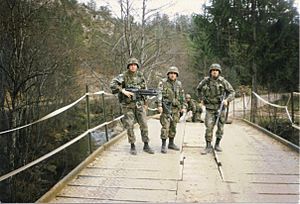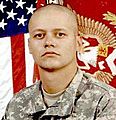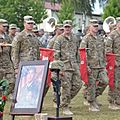9th Engineer Battalion (United States) facts for kids
Quick facts for kids 9th Engineer Battalion |
|
|---|---|
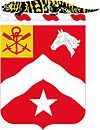
9th Engineer Battalion coat of arms
|
|
| Active | 1917–1945 1952–1991 1996–2013 2015–present |
| Country | |
| Branch | US Army Corps of Engineers |
| Type | Brigade Engineer Battalion (BEB) |
| Garrison/HQ | Fort Stewart, GA |
| Nickname(s) | Gilas; 9E |
| Motto(s) | "Asistiremos" (Spanish: We will assist); "First to Cross!" |
| Anniversaries | Crossing of the Ludendorff Bridge 7 March 1945 |
| Insignia | |
| Distinctive Unit Insignia |  |
The 9th Engineer Battalion is a special unit of the United States Army. Their job is to help soldiers move safely and build important structures. They are also known as "sappers," which is a name for combat engineers. Sappers are trained to clear paths, build bridges, and sometimes even fight as regular soldiers.
This battalion has a long history, serving in many conflicts around the world. They were active in World War I, World War II, and more recently in places like Iraq and Afghanistan. They are most famous for helping to capture the Ludendorff Bridge in Germany during World War II. Today, the 9th Engineer Battalion is based at Fort Stewart, Georgia.
Contents
- Symbols of the 9th Engineers
- A Look Back: History of the 9th Engineers
- Unit History Timeline
- Awards and Honors
- Brave Soldiers Who Fell
- Images for kids
- See also
Symbols of the 9th Engineers
The special crest, or symbol, of the 9th Engineer Battalion was approved in 1967. All the symbols on it tell a story about the battalion's early days in the southwestern United States.
- The Gila monster shows their service near the Gila River in the desert from 1917 to 1920.
- The ship anchor and oars come from their original parent unit, the 2nd Battalion Mounted Engineers.
- The horse head represents their time as "Mounted Engineers" (on horseback) and "Armored Engineers" (in tanks).
- The wavy line across the shield stands for their work along the Rio Grande river.
- The lone star at the bottom reminds everyone of their service in Texas.
- Their motto, "Asistiremos," means "We Will Assist" in Spanish.
A Look Back: History of the 9th Engineers
Early Days and Training
The 9th Engineer Battalion started on May 15, 1917. They were first called the 2nd Battalion Mounted Engineers. They began their training in Texas.
After World War I, most of the battalion became inactive. However, one company, called A Company, continued to train soldiers at Fort Riley, Kansas. They helped the Cavalry School with important training and building projects.
World War II: Fighting for Freedom
During World War II, the battalion was renamed the 9th Armored Engineer Battalion. They landed in France in October 1944. They helped the 9th Armored Division move across France and soon met the enemy.
The Battle of the Bulge
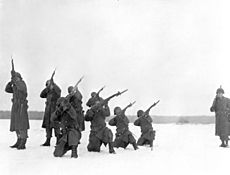
The battalion played a big part in the Battle of the Bulge in December 1944. This was a major battle where German forces tried to break through Allied lines.
- B Company worked to prepare bridges for demolition if needed. They also improved roads and laid minefields to stop the enemy.
- C Company helped defend Bastogne, a very important town. They blocked six roads, stopping the German advance for days. Their bravery earned them a special award called the Presidential Unit Citation.
Capturing the Ludendorff Bridge
On March 7, 1945, the 9th Armored Division reached the town of Remagen. To their surprise, the Ludendorff Bridge over the Rhine River was still standing! German soldiers had tried to blow it up, but they failed.
A small team from B Company, including Lieutenant Hugh Mott, Staff Sergeant John Reynolds, and Sergeant Eugene Dorland, quickly moved to the bridge. Dorland bravely destroyed the main switch for the explosives. Other engineers followed, finding and removing more bombs.
After securing the bridge, B Company quickly made repairs. This allowed the first Sherman tanks to cross the Rhine River. This was a huge moment because it was the first time Allied forces had crossed the Rhine since the time of Napoleon!
The next day, C Company kept the bridge open despite constant attacks from enemy artillery and planes. They even put up a sign that said, "CROSS THE RHINE WITH DRY FEET COURTESY OF 9TH ARMD DIV." The 9th Engineers were crucial in creating this important bridgehead. For their actions at Remagen, they received another Presidential Unit Citation.
After the war ended, the battalion helped with occupation duties in Germany. They were then inactivated in October 1945.
The Cold War: Standing Guard
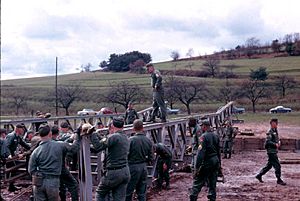
In 1952, the 9th Engineers were reactivated. They moved to Germany and helped protect West Germany from a possible Communist invasion. They trained and worked to deter any attacks.
The Persian Gulf War: Desert Storm
In 1991, the 9th Engineers supported the 1st Infantry Division during the Persian Gulf War. They helped lead the division through the "Desert Breach" and played a part in freeing Kuwait. After their mission, they returned to Germany and were inactivated again in 1992.
The Balkans: Peacekeeping Missions
The battalion was reactivated in Germany in 1996. They deployed to Bosnia as part of a peacekeeping mission. Their tasks included:
- Clearing and marking minefields.
- Reconnaissance (scouting) for bridges, roads, and minefields.
- Destroying hidden weapons.
- Working with Russian soldiers at checkpoints.
For their work in Bosnia, the battalion received the Army Superior Unit Award.
The 9th Engineers also deployed to Kosovo in 1999 and again in 2002. In Kosovo, they helped build and secure areas, clear unexploded bombs, and improve roads. They even secured an airfield for a visit from President Bill Clinton.
Iraq War: Supporting Operations
First Deployments
In 2003, the 9th Engineers prepared for the 2003 invasion of Iraq. Later, in February 2004, they deployed to Kuwait for training before moving into Iraq for Operation Iraqi Freedom (OIF) II.
In Iraq, the battalion, known as Task Force 9th Engineer, worked in various areas. They returned to Germany in February 2005.
Later Deployments
In September 2006, the 9th Engineers deployed again to Iraq.
- Charlie Company focused on clearing routes in Ramadi.
- Alpha and HHC (Headquarters and Headquarters Company) worked in Baghdad. They helped set up the "Baghdad Security Belt," which was a system of obstacles and checkpoints around the city.
- Bravo Company fought as infantry and later cleared routes in Eastern Baghdad.
The battalion returned to Germany in November 2007.
They deployed to Iraq again in November 2008. They supported operations in five different provinces. Under new rules, they worked closely with Iraqi forces. They helped the Iraqi Police and Army secure voting sites for local elections.
- Alpha Company found many unexploded bombs and cleared thousands of kilometers of roads. They also built and demolished structures.
- Bravo Company cleared routes, finding many hidden bombs. They also destroyed enemy hideouts and unexploded ordnance. They received the "Itschner Award" for being one of the best engineer companies.
- Charlie Company conducted route clearance and general engineering missions in several provinces.
The battalion returned to Germany in November 2009.
Afghanistan: Enduring Freedom
In July 2011, the 9th Engineer Battalion, called Task Force Gila, deployed to eastern Afghanistan for Operation Enduring Freedom.
- HHC trained and partnered with Afghan police forces.
- Alpha Company cleared routes and improved roads. They worked closely with Afghan engineers.
- Bravo Company fought as infantry and worked with Afghan security forces to improve safety in their area. They trained Afghan soldiers and police.
- Charlie Company also fought as infantry and conducted counterinsurgency operations with the Afghan Army. Their efforts may have helped local people rise up against the Taliban in 2012.
Task Force Gila returned to Germany in June 2012 and was inactivated in May 2013.
As of May 2015, the battalion is active again as the 9th Brigade Engineer Battalion (9th BEB) at Fort Stewart, Georgia.
Unit History Timeline
Here's a quick look at the 9th Engineer Battalion's journey:
- 1917: Started as the 2nd Battalion, Mounted Engineers in Texas.
- 1917: Renamed the 9th Engineers.
- 1922: Most of the battalion became inactive.
- 1941: Activated again.
- 1942: Renamed the 9th Armored Engineer Battalion and joined the 9th Armored Division.
- 1944: Deployed to England, then France. Fought in the Rhineland Campaign and Ardennes-Alsace Campaign (Battle of the Bulge).
- 1945: Fought in the Central Europe Campaign and captured the Ludendorff Bridge.
- 1945: Inactivated in Virginia.
- 1952: Reactivated as the 9th Engineer Combat Battalion in Washington.
- 1953: Renamed the 9th Engineer Battalion.
- 1957: Moved to Germany, serving during the Cold War.
- 1991: Supported the 1st Infantry Division in the Persian Gulf War.
- 1992: Inactivated in Germany.
- 1996: Reactivated in Germany and joined the 1st Infantry Division.
- 1996-2002: Deployed to the Balkans (Bosnia and Kosovo) for peacekeeping.
- 2003-2010: Deployed multiple times to Iraq for Operation Iraqi Freedom.
- 2008: Joined the 172nd Infantry Brigade Combat Team.
- 2011-2012: Deployed to Afghanistan for Operation Enduring Freedom.
- 2013: Inactivated in Germany.
- 2015: Activated again at Fort Stewart, Georgia, as the 9th Brigade Engineer Battalion.
Awards and Honors
The 9th Engineer Battalion has earned many awards for its brave service:
Campaigns They Fought In
- World War II:
* Rhineland * Ardennes-Alsace * Central Europe
- Southwest Asia (Persian Gulf War):
* Defense of Saudi Arabia * Liberation and defense of Kuwait * Cease-fire
- Kosovo:
* Kosovo Defense Campaign
* Iraq: * Transition of Iraq * Iraqi governance * National resolution * Iraqi surge * Afghanistan: * Transition I
Special Unit Awards
- Valorous Unit Award for actions in Samarra, Iraq.
- Meritorious Unit Commendation for service in Iraq (2004–2005, 2008-2009) and Afghanistan (2011-2012).
- Army Superior Unit Award for service in 1996–1997.
Each company also has its own special awards:
- Headquarters Company: Meritorious Unit Commendation for European Theater.
- Company A:
* Presidential Unit Citation for Luxembourg. * Valorous Unit Award for Iraq-Kuwait (1991) and Baghdad (2006-2007).
- Company B:
* Presidential Unit Citation for St. Vith, Remagen Bridgehead, and Adhamiyah District, Baghdad. * Valorous Unit Award for Paktika Province, Afghanistan (2011). * Meritorious Unit Commendation for Iraq (2008-2009). * Cited by the Belgian Army for actions in the Ardennes.
- Company C:
* Presidential Unit Citation for Bastogne and Remagen Bridgehead. * Meritorious Unit Commendation for Afghanistan (2011-2012). * Belgian Croix de Guerre with Palm for Bastogne.
Brave Soldiers Who Fell
These soldiers from the 9th Engineer Battalion gave their lives serving their country.
Images for kids
See also
- Military engineering of the United States
- Combat engineer
- Military engineering


